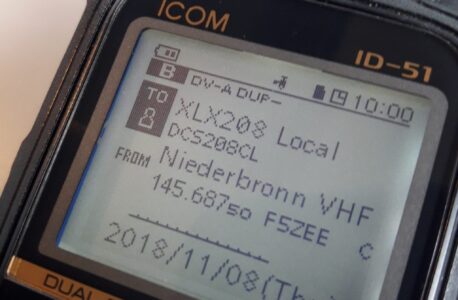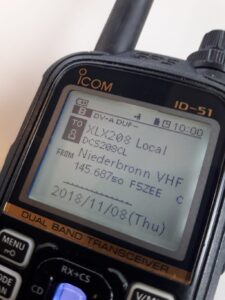Contents
This is a question often raised by beginners to DStar : what is the difference between all those reflector types? I’ll try to give you an insight on this throughout this article.
What is a reflector ?
To begin this article I would like to make a small recall on what a reflecor is. A reflecor is a software running on a computer with no radios attached to it, typically a server in a datacenter, to which repeaters and hotspots connect to. A reflector can be thought of an audio conference server.
Each reflector has different modules, identified with letters. The modules can be seen as conferene rooms within the conference server. Repeaters/hotspots connect to a module of the reflector. Whenever someone transmits via radio onto a repeater/hotspot connected to this reflector module the transmission will be rebroadcasted toward all other repeaters/hotspots connected to that same reflector. The transmission gets reflected to all connected repeaters/hotspots, hence the name reflector module.
Ok now, what is the difference between all those flavours of reflectors? Virtually there is no difference or, at least, not for the people who are just using them.
The different reflector systems
REF
The first reflectors were the REF reflectors. A list of those reflectors can be found here. To convey the DStar information the software used to run a REF reflector uses a network protocol called DPlus to communicate with the repeaters. The DPlus protocol requires you to be registered into the US-Trust system, but I will cover this in a later article. To connect your repeater to a REF reflector you’ll issue a command REFxxxaL on your radio, replacing xxx with the wanted number and a with the wanted module.
XRF
The second type of reflectors that came up were the XRF reflectors. A list of those reflectors can be found here. The software used to run the XRF reflector uses another network protocol called DExtra. To connect your repeater to a XRF reflector you’ll issue a command XRFxxxaL on your radio, replacing xxx with the wanted number and a with the wanted module.
DCS
The DCS reflectors arrived later and originated in Germany. It is/was a centralized system ran by German hams. If you wanted to run a reflector you had to give admin rights to some german OMs who installed the software for you on your server. Quite awkward. Ok focus back. The DCS reflectors also come with their own network protocol. The protocol here is simply called DCS. Recently the OMs in charge of the DCS decided to drop the system, but some fellow hams decided to take it over. To connect your repeater to a DCS reflector you’ll issue a command DCSxxxaL on your radio, replacing xxx with the wanted number and a with the wanted module.
XLX
Now we went through all three historical reflector and you are probably thinking “Ok no need to continue reading, he’ll tell us XLX is a reflector that speaks XLX protocol”… Nope! You are wrong! Continue reading!
The software used to run the XLX reflectors actually speaks all three previous protocols REF, XRF, DCS and additionaly its own protocol which is only used to interconnect reflectors together. As a side note, XLX reflectors are very versatile and can also be accessed through DMR and Fusion with full audio transcoding. For the sake of clarity this aspect will not be covered here.
Back to DStar. The 3 protocols (DCS,XRF,DCS) capability brought lots of confusion and still confuses DStar newbies : some reflector sysops did not do their homework and just hijacked reflector numbers that were used in the legay XRF and DCS systems. This caused names collision and sometime you did not know if you were really connected to where you wanted to connect.
Let’s assume you want to connect to XLX208C. According to the previous examples with REF, XRF and DCS you would expect to have to issue the command XLX208CL from your radio. Unfortunately, this will lead you nowhere. You’ll need to issue either XRF208CL or DCS208CL. Both commands will connect your repeater to XLX208 module C the first one using the Dextra protocol, the other using the DCS protocol. If two repeaters connect to the same reflector module using different protocols the reflector software will convert protocols back and forth i.e. a repeater connected using DExtra will be get the transmissions from the one connected through DCS and vice versa.
It’s worth mentioning all those different protocols are network protocols, once the transmission reaches the radio side it is just sent out as plain DStar.


Hey Chris! I’m not new to D-STAR, but I am new to venturing beyond the REF groups. I’m hoping to join the Boredom Breakers net through my DV-Mega. Their website says that the appropriate connection is “XLXOKL A.” I’m accustomed to seeing the “L” at the end. Should I enter “XRFOKL A” or “XRFOKA L?” Which is the appropriate entry? Thanks! -Scott
I believe this person has stolen your article.
https://www.m7spi.co.uk/reflectors-explained/
Great article but I am a little confused. As a new user of an ICOM ID-5100 I just entered by hand “link to XLXOKLBL” and the DSTAR repeater I use connected to XLXOKL B. I made radio contact with another station that was using a hotspot so I’m positive it worked. Does the 5100 work differently with the XLX protocol?
Hi Chris,
As said in the article, once the communication reaches the radio part of the network it is just plain DStar. The 5100 just says to the repeater “please connect to XLX0KL module B”. Once the transmission is on the internet this is where the different protocols come to play. REF, XRF etc are just different “internet” protocol for the repeaters to talk to each other or to the reflectors.
I hope this made it clearer.
So we’re can I go to get a deeper understanding of using xlx reflectors. I want to connect my dmr ht to a friends DStar mobile radio using my hotspot. I am thinking there might be more than one way to do this.
Hi,
there are some prerequsite to this :
I still don’t get then how to connect to a XLX reflector or if you should try. Take a site like http://xrefl.net/ for example. It only gives 6 digits. How does one know which module to add? Never mind that, you said they don’t work even if you add module and link commands. XLXyyyAL. So do you arbitrarily change them to REF, XRF or DCS followed by the same 3 digit number as the XLX ? Does it matter which one of the three ? And THEN add module number (if you know where to find it) and L. Thx : ‘ )
Not sure to understand what you are trying to do… but here is an example. I’ll take XLX208 because I am administering it and know it is reachable over any protocol.
Imagine you want to connect to XLX208 Module C you could do so by using the following commands :
XRF208CL will connect you using Dextra protocol
DCS208CL will connect you using DCS protocol
REF208CL will connect you using REF protocol
XLX208CL will connect you using … DCS protocol but this is a special case, and we’ll ignore it.
Rule of thumb is first 3 digits are the protocol, 3 middle digits reflector, 6th digits is the module letter and L stand for link command.
On this page https://xlx208.f5kav.fr/index.php?show=repeaters you can see the different repeaters connected to XLX208 and which protocol they are using.
Let me know if this helps !
Thank you for the great explanation Dan. I was confused for a while about the different reflector types, but your article is excellent. 73, KM4SFF
My apologies – I meant Geoffrey.
You’re welcome 😉
I would like a little further clarification, Is XRF backwards compatible with REF? If not how is XLX compatible with both different types of protocols without messing up one or the other, for example one reflector is using the REF protocol, lets call this reflector REF 001C and another reflector is using the XRF protocol, lets call this reflector XRF 001C. On top of those reflectors there’s a reflector that’s using the XLX protocol, let’s call this reflector XLX 001C.
Hi Dan,
REF reflectors were not interlinked. The legacy XRF reflectors could interconnect together and so can the XLX. Legacy XRF reflectors used the Dextra protocol to interlink whereas XLX use their own XLX protocol (which is actually a derivative of XRF).
If you try to connect your repeater or hotspot to a REF (DPlus) reflector using XRF (DExtra) or DCS porotocol you will go nowhere. It will not work.
The XLX reflector software converts the protocols on the fly. If one repeater is connected using XRF/DExtra and the other using DCS it will convert the protocols bqck and forth.
I hope I have answered your question and wish you and loved one a happy new year 🙂
73
Yes it did, thanks so much for the reply /info
Pingback: XLX reflector direct connection | | F4FXL
Pingback: ircddb and quadnet, what is this all about ? – F4FXL
Thanks for the useful information and it was nice chatting with you this morning.
73 Bob,
M0BOB
Thank you! You are very welcome on DCS208 anytime!
Nice job of explaining.
Thank you 🙂